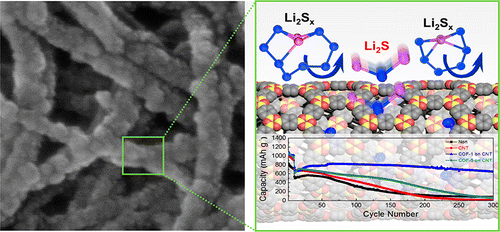当前位置:
X-MOL 学术
›
Nano Lett.
›
论文详情
Our official English website, www.x-mol.net, welcomes your
feedback! (Note: you will need to create a separate account there.)
COF-Net on CNT-Net as a Molecularly Designed, Hierarchical Porous Chemical Trap for Polysulfides in Lithium–Sulfur Batteries
Nano Letters ( IF 9.6 ) Pub Date : 2016-04-28 00:00:00 , DOI: 10.1021/acs.nanolett.6b00870
JongTae Yoo , Sung-Ju Cho , Gwan Yeong Jung , Su Hwan Kim , Keun-Ho Choi , Jeong-Hoon Kim , Chang Kee Lee 1 , Sang Kyu Kwak 2 , Sang-Young Lee
Nano Letters ( IF 9.6 ) Pub Date : 2016-04-28 00:00:00 , DOI: 10.1021/acs.nanolett.6b00870
JongTae Yoo , Sung-Ju Cho , Gwan Yeong Jung , Su Hwan Kim , Keun-Ho Choi , Jeong-Hoon Kim , Chang Kee Lee 1 , Sang Kyu Kwak 2 , Sang-Young Lee
Affiliation

|
The hierarchical porous structure has garnered considerable attention as a multiscale engineering strategy to bring unforeseen synergistic effects in a vast variety of functional materials. Here, we demonstrate a “microporous covalent organic framework (COF) net on mesoporous carbon nanotube (CNT) net” hybrid architecture as a new class of molecularly designed, hierarchical porous chemical trap for lithium polysulfides (Li2Sx) in Li–S batteries. As a proof of concept for the hybrid architecture, self-standing COF-net on CNT-net interlayers (called “NN interlayers”) are fabricated through CNT-templated in situ COF synthesis and then inserted between sulfur cathodes and separators. Two COFs with different micropore sizes (COF-1 (0.7 nm) and COF-5 (2.7 nm)) are chosen as model systems. The effects of the pore size and (boron-mediated) chemical affinity of microporous COF nets on Li2Sx adsorption phenomena are theoretically investigated through density functional theory calculations. Benefiting from the chemical/structural uniqueness, the NN interlayers effectively capture Li2Sx without impairing their ion/electron conduction. Notably, the COF-1 NN interlayer, driven by the well-designed microporous structure, allows for the selective deposition/dissolution (i.e., facile solid–liquid conversion) of electrically inert Li2S. As a consequence, the COF-1 NN interlayer provides a significant improvement in the electrochemical performance of Li–S cells (capacity retention after 300 cycles (at charge/discharge rate = 2.0 C/2.0 C) = 84% versus 15% for a control cell with no interlayer) that lies far beyond those accessible with conventional Li–S technologies.
中文翻译:

CNT-Net上的COF-Net是一种分子设计的锂硫电池中多硫化物的分层多孔化学阱。
作为一种多尺度工程策略,分层多孔结构已经引起了广泛的关注,以在各种功能材料中带来无法预料的协同效应。在这里,我们展示了一种“介孔碳纳米管(CNT)网上的微孔共价有机骨架(COF)网”混合体系结构,它是一类新的分子设计的,用于多硫化锂(Li 2 S x)装在Li–S电池中。作为混合体系结构概念的证明,通过CNT模板原位COF合成技术,在CNT-net中间层(称为“ NN中间层”)上构建了独立的COF-net,然后将其插入硫阴极和分隔器之间。选择具有不同微孔尺寸的两个COF(COF-1(0.7 nm)和COF-5(2.7 nm))作为模型系统。通过密度泛函理论计算,从理论上研究了微孔COF网的孔径和(硼介导的)化学亲和力对Li 2 S x吸附现象的影响。得益于化学/结构的独特性,NN中间层可有效捕获Li 2 S x而不损害它们的离子/电子传导。值得注意的是,在设计良好的微孔结构的驱动下,COF-1 NN中间层可实现电惰性Li 2 S的选择性沉积/溶解(即轻松的固-液转化)。因此,COF-1 NN中间层极大地改善了Li–S电池的电化学性能(300次循环后的容量保持率(在充电/放电速率= 2.0 C / 2.0 C时)= 84%,而没有中间层的对照电池则为15%)超越了传统的Li–S技术可访问的范围。
更新日期:2016-04-28
中文翻译:

CNT-Net上的COF-Net是一种分子设计的锂硫电池中多硫化物的分层多孔化学阱。
作为一种多尺度工程策略,分层多孔结构已经引起了广泛的关注,以在各种功能材料中带来无法预料的协同效应。在这里,我们展示了一种“介孔碳纳米管(CNT)网上的微孔共价有机骨架(COF)网”混合体系结构,它是一类新的分子设计的,用于多硫化锂(Li 2 S x)装在Li–S电池中。作为混合体系结构概念的证明,通过CNT模板原位COF合成技术,在CNT-net中间层(称为“ NN中间层”)上构建了独立的COF-net,然后将其插入硫阴极和分隔器之间。选择具有不同微孔尺寸的两个COF(COF-1(0.7 nm)和COF-5(2.7 nm))作为模型系统。通过密度泛函理论计算,从理论上研究了微孔COF网的孔径和(硼介导的)化学亲和力对Li 2 S x吸附现象的影响。得益于化学/结构的独特性,NN中间层可有效捕获Li 2 S x而不损害它们的离子/电子传导。值得注意的是,在设计良好的微孔结构的驱动下,COF-1 NN中间层可实现电惰性Li 2 S的选择性沉积/溶解(即轻松的固-液转化)。因此,COF-1 NN中间层极大地改善了Li–S电池的电化学性能(300次循环后的容量保持率(在充电/放电速率= 2.0 C / 2.0 C时)= 84%,而没有中间层的对照电池则为15%)超越了传统的Li–S技术可访问的范围。































 京公网安备 11010802027423号
京公网安备 11010802027423号